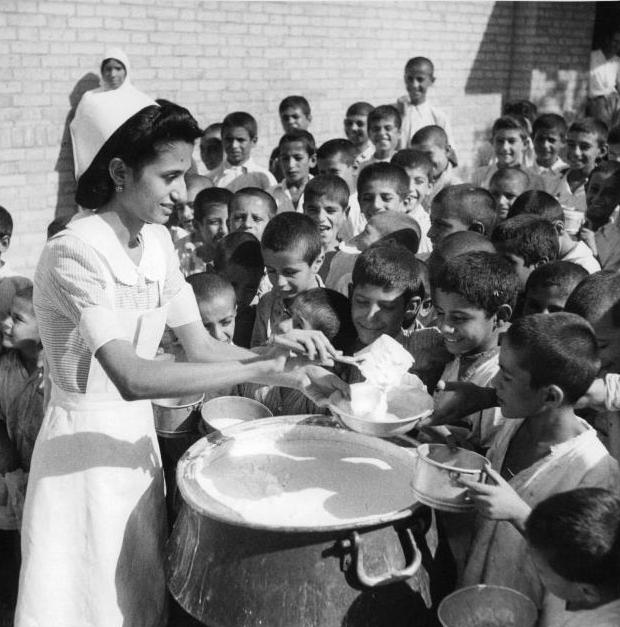
Pahlavi Era: Modernization and Reform--White Revolution

Figure 1.--Until the Pahlavi era. Iran like most of the Middle East did not have a modern health care system. There were few doctors with medical degrees and limited hospital facilities. In the country side here was next to nothing in the way of health care facuilities. Boyh the Shah and his father gave considerable priority to building a modern health care suystem. Here children in Abidan receive free milk at a clinic built by the Anglo-Iranian Oil Company in 1951.
|
|
The Mohammed Reza Shah domestically pursued a wide range of reform policies. This culminating in the 1963 program which became known as the White Revolution. The Shah's father, Reza Shah had ambitions for modernizing his country. They included founding industries, important infrastructure projects (especially railroads), a public education system, judicial reform, and a modern health care system. Some limited progress was achieved, but the money did not exist for what he wanted, but the creation of a modern country began. He did send hundreds of Iranians to Europe for training. The Germand priovided many technical adbisers, creating friction with the Bruitish. The new Shah had much more money to fund projects because of the rising oil revenue. He continued his father's projects and the Americans during Workld War created a modern transport system that Reza Shah could have only dreamed of. The new Shah pursued land reform, the extension of voting rights to women, and the elimination of illiteracy. Substantial investments were made in both education and health care. These developments projects transformed Iran into the most industrial and urbanized country in the Mideast. Public education and ecomnomic development created a substantial new middle-class as well as competent professionals and an industrial urban working class. The White Revolution reforms and changes provoked religious leaders, most with rural backgroundsand limired educations. A major objection was education and rights for women. Voting was one matter, but female dress, education, and social status were all maters that concerned conservative Islamic religious leaders. They also began to fear losing their traditional authority. They began to criticize the Shah which led to some civil unrest.
Sources
Kinzer, Stephen. All the Shah's Men: An American Coup and the Roots of Middle East Terror (Hoboken, NJ: John Wiley & Sons, 2003).
CIH

Navigate the Children in History Website:
[Return to the Main Iranian Mohammed Reza Shah Era page]
[Return to the Main Iranian Pahlavi Era page]
[Return to the Main Iranian history page]
[Return to the Main Iranian page]
[Return to the Main Middle Eastern history page]
[Return to the Main Middle Eastern page]
[Introduction]
[Animals]
[Biographies]
[Chronology]
[Climatology]
[Clothing]
[Disease and Health]
[Economics]
[Geography]
[History]
[Human Nature]
[Law]
[Nationalism]
[Presidents]
[Religion]
[Royalty]
[Science]
[Social Class]
[Bibliographies]
[Contributions]
[FAQs]
[Glossaries]
[Images]
[Links]
[Registration]
[Tools]
[Children in History Home]
Created: 4:19 AM 5/10/2018
Last updated: 4:20 AM 5/10/2018



